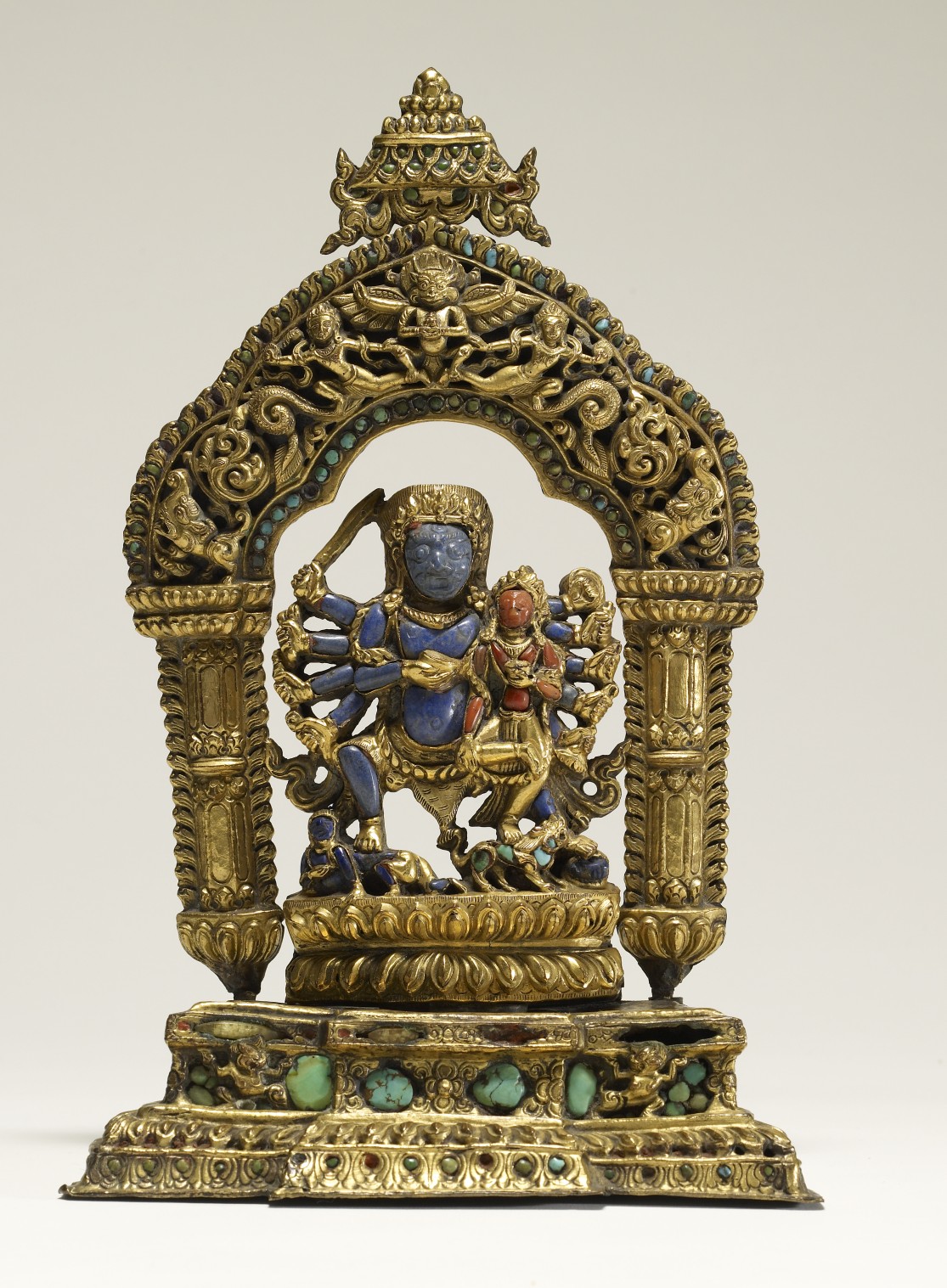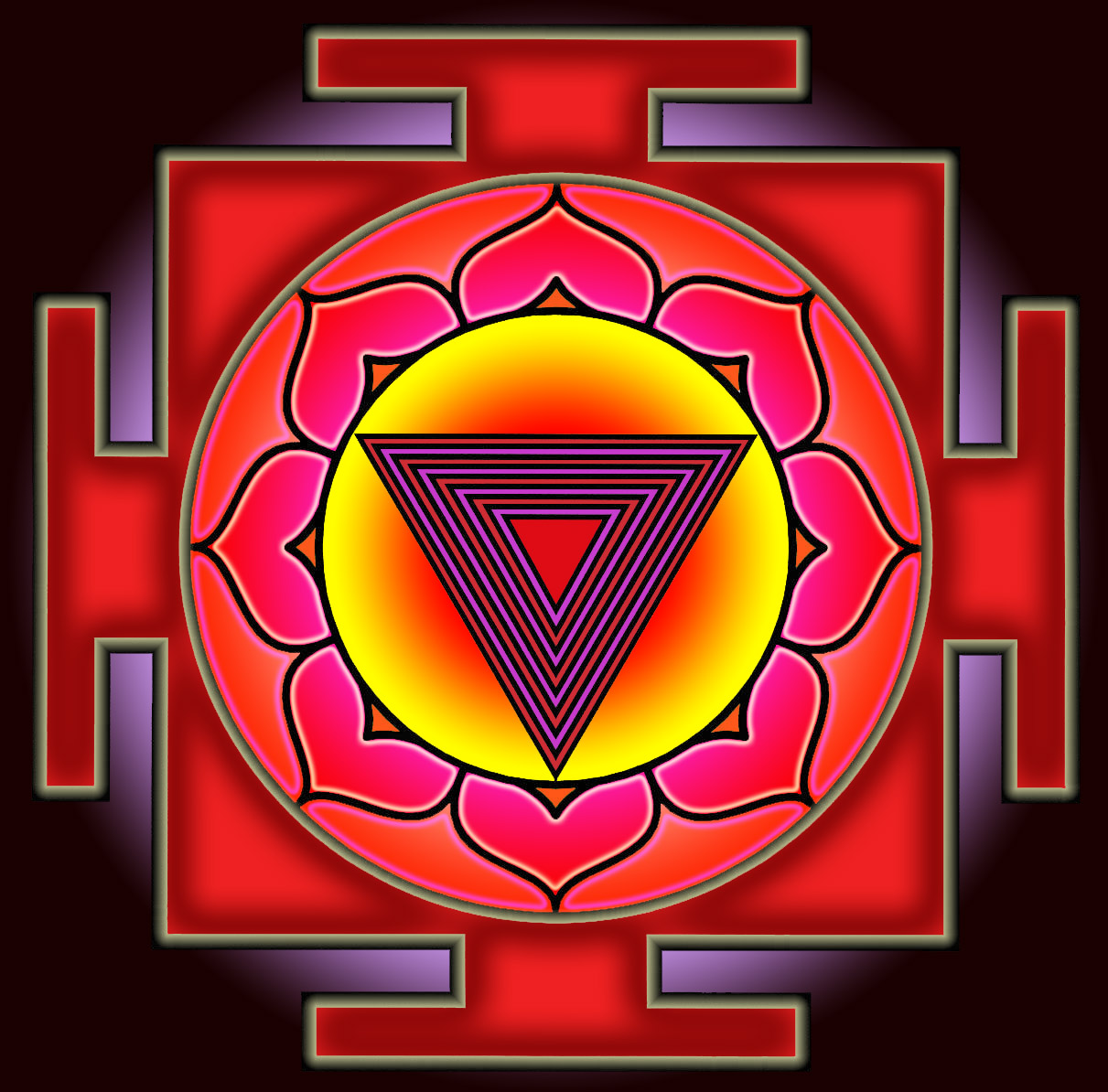Bhairavi on:
[Wikipedia]
[Google]
[Amazon]
Bhairavi ( sa, भैरवी) is a
 Her dhyana
Her dhyana  Tripurabhairavī is said to be residing in muladhara chakra. Her mantra consists of three letters and they all form an inverted triangle in the centre of muladhara chakra. She is the creator in muladhara chakra in the form of kamarupa, which consists of three dots forming an inverted triangle, from which all triads are born, which ultimately leads to the creation of this universe. The innermost triangle of muladhara chakra is known as kamarupa. The three points of triangle have three bijaksaras (sacred letters) and the three bijaksaras connected to each other by the sides of the triangle and each of these sides represent iccha sakthi, jnana sakthi and kriya sakti or the Divine will, Divine knowledge and Divine action.
Tripurabhairavī is said to be residing in muladhara chakra. Her mantra consists of three letters and they all form an inverted triangle in the centre of muladhara chakra. She is the creator in muladhara chakra in the form of kamarupa, which consists of three dots forming an inverted triangle, from which all triads are born, which ultimately leads to the creation of this universe. The innermost triangle of muladhara chakra is known as kamarupa. The three points of triangle have three bijaksaras (sacred letters) and the three bijaksaras connected to each other by the sides of the triangle and each of these sides represent iccha sakthi, jnana sakthi and kriya sakti or the Divine will, Divine knowledge and Divine action.
Hindu Goddesses: Vision of the Divine Feminine in the Hindu Religious Traditions
'' University of California Press. . * * R. D. Trivedi: Iconography of Parvati (Delhi, 1981) {{Authority control Hindu goddesses Forms of Parvati Mahavidyas
Hindu
Hindus (; ) are people who religiously adhere to Hinduism. Jeffery D. Long (2007), A Vision for Hinduism, IB Tauris, , pages 35–37 Historically, the term has also been used as a geographical, cultural, and later religious identifier for ...
goddess, described as one of the Mahāvidyas, the ten avatars of the mother goddess. She is the consort of Bhairava
Bhairava (Sanskrit: भैरव ) or Kala Bhairava is a Shaivite and Vajrayāna deity worshiped by Hindus and Buddhists. In Shaivism, he is a powerful manifestation, or avatar, of Shiva associated with annihilation. In Trika system ''Bhaira ...
.
Etymology
The name ''Bhairavi'' means "terror" or "awe-inspiring". She is the fifth of ten Mahāvidyas. She is also called Tripurabhairavi. "Tri" means three, "Pura" means fortress, castle, city, town, etc. Tripura convey three different stages of consciousness i.e. active, dream and deep sleep. She is in the form of all triads and once these triads are transcended, it is believed thatBrahman
In Hinduism, ''Brahman'' ( sa, ब्रह्मन्) connotes the highest universal principle, the ultimate reality in the universe.P. T. Raju (2006), ''Idealistic Thought of India'', Routledge, , page 426 and Conclusion chapter part X ...
is attained. Hence, she is called Tripurabhairavi.
Iconography
 Her dhyana
Her dhyana shloka
Shloka or śloka ( sa, श्लोक , from the root , Macdonell, Arthur A., ''A Sanskrit Grammar for Students'', Appendix II, p. 232 (Oxford University Press, 3rd edition, 1927). in a broader sense, according to Monier-Williams's dictionary, is ...
in the Devi Mahatmya describes her form. She is seated on a lotus with four hands, one with a book, one with rosary beads, one with abhaya mudra and another with varada mundra. She wears red garments and wears a garland of severed heads around her neck. She has three eyes and her head is adorned with a crescent moon. In another form she is carrying a sword and a cup containing blood and other two hands showing abhaya and varada mudras. She is also depicted as sitting on Shiva, which is more predominant in tantric worship. She is also depicted as a queen, closely resembling Rajarajeswari. Tripurabhairavī is said to be residing in muladhara chakra. Her mantra consists of three letters and they all form an inverted triangle in the centre of muladhara chakra. She is the creator in muladhara chakra in the form of kamarupa, which consists of three dots forming an inverted triangle, from which all triads are born, which ultimately leads to the creation of this universe. The innermost triangle of muladhara chakra is known as kamarupa. The three points of triangle have three bijaksaras (sacred letters) and the three bijaksaras connected to each other by the sides of the triangle and each of these sides represent iccha sakthi, jnana sakthi and kriya sakti or the Divine will, Divine knowledge and Divine action.
Tripurabhairavī is said to be residing in muladhara chakra. Her mantra consists of three letters and they all form an inverted triangle in the centre of muladhara chakra. She is the creator in muladhara chakra in the form of kamarupa, which consists of three dots forming an inverted triangle, from which all triads are born, which ultimately leads to the creation of this universe. The innermost triangle of muladhara chakra is known as kamarupa. The three points of triangle have three bijaksaras (sacred letters) and the three bijaksaras connected to each other by the sides of the triangle and each of these sides represent iccha sakthi, jnana sakthi and kriya sakti or the Divine will, Divine knowledge and Divine action. Tripura Sundari
Tripura Sundari (Sanskrit: त्रिपुरा सुन्दरी, IAST: Tripura Sundarī), also known as Rajarajeshwari, Shodashi, Kamakshi, and Lalita is a Hindu goddess, worshipped as a principal aspect of supreme goddess Mahadevi ...
and Tripura Bhairavi are closely associated but different. Tripura Bhairavi is posited as the latent energy whereas Tripura Sundarī who causes this latent energy to actualize and moves this energy upwards towards higher chakras till Sahasrara Chakra.
Legend
Bhairavi is also a title for a female adept inKundalini
In Hinduism, Kundalini ( sa, कुण्डलिनी, translit=kuṇḍalinī, translit-std=IAST, lit=coiled snake, ) is a form of divine feminine energy (or ''Shakti'') believed to be located at the base of the spine, in the ''muladhara'' ...
, Tantra
Tantra (; sa, तन्त्र, lit=loom, weave, warp) are the esoteric traditions of Hinduism and Buddhism that developed on the Indian subcontinent from the middle of the 1st millennium CE onwards. The term ''tantra'', in the Indian ...
. A yogini
A yogini (Sanskrit: योगिनी, IAST: ) is a female master practitioner of tantra and yoga, as well as a formal term of respect for female Hindu or Buddhist spiritual teachers in Indian subcontinent, Southeast Asia and Greater Tibet. Th ...
is a student of Tantra or an aspirant. A ''Bhairavi'' is one who has succeeded. Bhairavi is the consort of Bhairava
Bhairava (Sanskrit: भैरव ) or Kala Bhairava is a Shaivite and Vajrayāna deity worshiped by Hindus and Buddhists. In Shaivism, he is a powerful manifestation, or avatar, of Shiva associated with annihilation. In Trika system ''Bhaira ...
according to the Puranas and Tantras
Tantras ("''doctrine''" or "''framework''" or "''system''" ) refers to numerous and varied scriptures pertaining to any of several esoteric traditions rooted in Hindu and Buddhist philosophy. The religious culture of the Tantras is essentially ...
.
She is seen mainly as Kalaratri in Durga Saptashati
The ''Devi Mahatmya'' or ''Devi Mahatmyam'' ( sa, देवीमाहात्म्यम्, devīmāhātmyam, Glory of the Goddess) is a Hindu philosophical text describing the Goddess as the supreme power and creator of the universe. It is ...
who slays Chanda, Munda and Raktabija. She slays Bhandasura in the Mahabharata
The ''Mahābhārata'' ( ; sa, महाभारतम्, ', ) is one of the two major Sanskrit literature, Sanskrit Indian epic poetry, epics of ancient India in Hinduism, the other being the ''Ramayana, Rāmāyaṇa''. It narrates the s ...
.
She is also called as Shubhankari, which means that she is the doer of auspicious deeds to her devotees who are her children, which means she is a good mother. She also favors violence, punishment and bloodshed to those who are irreligious and cruel, which also means that she is the mother of all violence to them. She is said to be seen as violent and terrible but is a benign mother to her children.
See also
* Devi *Mahakali
Mahakali () is the Hindu goddess of time and death in the goddess-centric tradition of Shaktism.
Similar to Kali, Mahakali is a fierce goddess associated with universal power, time, life, death, and both rebirth and liberation. She is the cons ...
* Mahavidya
* Bhramari
Notes
References
* Kinsley, David (1988).Hindu Goddesses: Vision of the Divine Feminine in the Hindu Religious Traditions
'' University of California Press. . * * R. D. Trivedi: Iconography of Parvati (Delhi, 1981) {{Authority control Hindu goddesses Forms of Parvati Mahavidyas